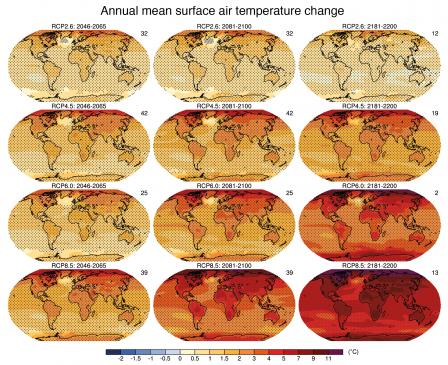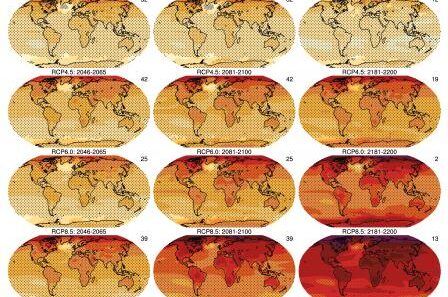The specter of climate change looms larger than ever on the global horizon, demanding our attention and action. The multifaceted implications of a warming planet penetrate various realms of existence. With escalating greenhouse gas emissions, it is vital to contemplate the underlying mechanics of climate change and predict the myriad alterations we may encounter in the future. This forecast seeks to explore potential changes through diverse lenses, evaluating their effects on ecosystems, weather patterns, and socio-economic frameworks.
Firstly, one of the most pressing changes anticipated is the elevation of global temperatures. The scientific consensus indicates that average surface temperatures could rise between 1.5 to 4 degrees Celsius by the end of the 21st century. The ramifications of such an increase are profound. Regions previously considered temperate may experience extreme heat events, leading to deleterious health outcomes, increased morbidity, and elevated mortality rates. Conversely, polar regions, particularly the Arctic, face accelerated melting of ice sheets and glaciers, which inexorably affects sea levels. Coastal communities could see formidable challenges, including heightened flooding, saltwater intrusion into freshwater aquifers, and, ultimately, displacement of populations.
In tandem with rising temperatures, precipitation patterns are projected to shift markedly. Some areas will confront intensified drought conditions, while others may experience increased precipitation, leading to a greater incidence of floods. Sub-Saharan Africa, for instance, may find its agricultural outputs severely hampered by protracted droughts, exacerbating food insecurity. The consequences of such disparities are far-reaching, leading to potential resource conflicts and economic destabilization in sensitive regions. In contrast, areas experiencing excessive rainfall may grapple with infrastructure failures and overwhelming disaster response demands. The unpredictability of these patterns serves to heighten the urgency with which global governance must address climate change mitigation strategies.
Another critical aspect of climate change is its effect on ecosystems and biodiversity. As habitats and climatic zones shift, many species will find themselves either adapting swiftly or facing extinction. Terrestrial and marine ecosystems are particularly vulnerable. Coral reefs, often dubbed the “rainforests of the sea,” are projected to undergo significant bleaching events as ocean temperatures rise and acidity increases. This phenomenon could decimate marine biodiversity, displacing fish populations and disrupting the livelihoods of communities reliant on fishing. Moreover, terrestrial species will contend with fragmented habitats, as urbanization and agricultural expansion encroach upon their territories. Affected species may lack suitable migration corridors, leading to unsustainable population declines and loss of biodiversity.
The implications extend into the realm of human health. Climate change is already exacerbating respiratory ailments, vector-borne diseases, and heat-related illnesses. As changing weather patterns facilitate the spread of pathogens and vectors, diseases such as malaria and dengue fever are projected to reach new geographical territories. Vulnerable populations, particularly in developing nations, will bear the brunt of these shifts, where public health infrastructure may be inadequate to absorb the burgeoning healthcare burden. Increased heat events may also lead to unforeseen complications, particularly for the elderly and those with pre-existing health conditions.
From a socio-economic perspective, climate change can disrupt economies and exacerbate inequalities. Agricultural systems will face increasingly erratic climatic conditions, threatening food supply chains and contributing to volatile market prices. Countries that depend heavily on agriculture may find themselves at profound risk, particularly if diversification and technological advancement are lacking. Additionally, unemployment rates could rise as industries adapt to new realities or fail to pivot altogether. The specter of climate migration may emerge, with individuals seeking refuge from uninhabitable regions, thus catalyzing social tensions in receiving areas.
Urban areas, home to over half of the world’s population, present unique challenges in the face of climate change. Infrastructure must evolve to withstand extreme weather events, including hurricanes, flooding, and heat waves. Utility systems may be pushed beyond their limits, leading to disruptions in essential services such as water, electricity, and public transportation. The interconnectivity of urban systems means the failure of one can precipitate cascading effects throughout the entire city. As such, cities worldwide must invest in climate-resilient infrastructure and prioritize gentrification prevention in order to secure the welfare of their most vulnerable residents.
The economic transition towards renewable energy sources is paramount in combating future climate change. Investments in solar, wind, and other sustainable technologies can pivot economies towards sustainability while creating new employment opportunities. However, this transition must be managed astutely to prevent exacerbating inequality. Policies must incentivize equitable access to clean energy technologies, ensuring that marginalized communities benefit alongside more affluent ones.
In sum, the implications of climate change span a multitude of spheres, each interconnected yet distinct. The potential for rising temperatures, shifting precipitation patterns, and altered ecosystems presents challenges that require fervent attention and action. By recognizing the multi-layered impacts of climate change, society can develop comprehensive strategies to mitigate its repercussions. As the world moves forward, the collective collaboration of governments, businesses, and individuals is essential for crafting a sustainable future, as the time to act is unequivocally now.



